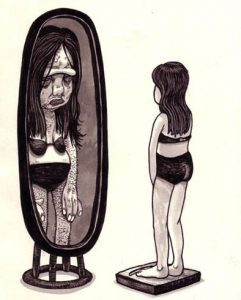In this post, blogger Olivia will be discussing her experience of body dysmorphic disorder, how it effects her everyday life and what she does to treat it.
What is body dysmorphic disorder?
Body dysmorphic disorder (BDD) is a type of anxiety disorder, where the person becomes fixated on either an imagined flaw, or a slight flaw, to the point of obsession. It goes beyond the normal type of self-consciousness and becomes something far more powerful and dominant – stopping sufferers from leading a normal life.
Olivia’s experience
It’s four in the morning and I can’t stop looking at my jaw. I’m staring into the mirror, the harsh bathroom light showing every little flaw – the way my mouth juts out to the left, the way my top teeth don’t quite touch the bottom, the way my face seems to droop. I’m exhausted but I can’t stop myself from running my finger along the bone, from my chin to my right ear and back again.
It’s difficult to know where to begin when I talk about my own experience with body dysmorphic disorder, or BDD as it’s more commonly known. Especially since, up until a few months ago, I didn’t even know that’s what I should call it. “It”, being the niggling thought I’ve had in my mind for a very long time – that my face is deformed.
Orthodontic problems
When I was a teenager, I underwent orthodontic treatment. I had braces for the guts of four years. As I was nearing the end of my journey as a metal-mouth, my orthodontist mentioned that my jaw was slightly misaligned. I had a crossbite, I could go for surgery – but it would be purely cosmetic, considering it didn’t affect me in my daily life.

Affecting everyday life
The thing is, it did affect me. Somehow, I went from not even knowing the flaw existed, to having it consume my every day life.
It was simple things at first, for example I only showed one side of my face in photos. But then, I sat in classrooms and lecture halls in a way that angled my jaw more favourably. As the BDD manifested itself more aggressively, it had worse implications. Sometimes I didn’t leave the house because I thought people would recoil in horror.
What are the causes?
For me, it’s my jaw. For others, it can be their skin, weight, nose, hair – BDD really isn’t picky. As for the cause, not much is known. There’s the thought that just like other mental illnesses, it can stem for a chemical imbalance in the brain. Or it can come from trauma, abuse, stress or even society’s emphasis on looking “perfect”.
How is it treated?
Currently the treatment for BDD is either Cognitive Behavioural Therapy (CBT), medication or a combination of the both. Like other illnesses, dealing with BDD is easier when you talk about it openly.
I’d sought treatment for depression before, but there was something daunting about saying the words “I think about my jaw a lot” aloud. When my therapist gave the suffering, worry, and nights crying at my reflection a name, it was a shock but a relief.
Know you’re not alone
I haven’t overcome the disorder yet. But knowing what it is, knowing that it’s not normal, that there are other people who feel the same way, and that I’m going to get help to tackle it – that’s what I cling to now. I hope one day, I’ll look in the mirror, and be happy with what’s staring back. I really do.
